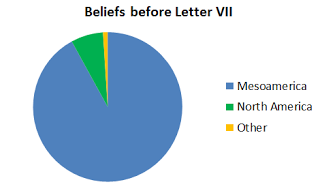___
Social-validation feedback loop
Consequently, these teachers do not know how frequently Letter VII was reprinted during Joseph’s lifetime, or how consistently Church leaders have reaffirmed it, including members of the First Presidency speaking in General Conference. But when they do learn the facts, these faculty tend to change their minds.
Data show the impact of Letter VII on LDS members’ belief in the Mesoamerican/two-Cumorahs theory before and after learning about Letter VII. When we look at these numbers, we see why the intellectuals continue to suppress and oppose Letter VII.
[Note: Most of those who retain a belief in Mesoamerica after learning about Letter VII are intellectuals who have taught or written about the Mesoamerican/two-Cumorahs theory or are otherwise invested in that theory for various reasons. For a list of reasons they’ve given for rejecting Letter VII, see here.]
As more BYU/CES teachers learn about Letter VII, the data suggest that believing and sustaining Joseph Smith and Oliver Cowdery will become more acceptable than the current practice of repudiating them.
They will then teach their students to sustain and believe the prophets and apostles by accepting Letter VII and all the consistent and repeated statements in support of the New York Cumorah.
Eventually, the North American setting will become the consensus view and social validation will switch.
2. Social-validation feedback loop. The Mesoamerican/two-Cumorahs theory has been the popular theory for intellectuals to believe because it portrays Joseph Smith and Oliver Cowdery as ignorant, uneducated men who changed their views when exposed to scholarly works. Their successors who affirmed Letter VII’s teachings about the New York Cumorah, including members of the First Presidency speaking in General Conference, were duped by the false tradition Joseph and Oliver started.
If you consider yourself an intellectual, you like to think your education and sophistication make your beliefs superior than those of mere Church prophets and apostles who started and perpetrated an ignorant folk belief about Cumorah being in New York.
Plus, as an intellectual, you must continue the tradition. You have to read, listen to, and repeat what the intellectuals at BYU have been promoting through FARMS, BYU Studies, the Interpreter, FairMormon, BMAF (and its corporate subsidiary Book of Mormon Central), Mesoamerican Meridian Magazine, and the rest.
If you toe the line of the Mesoamerican/two-Cumorahs theory, your students will think you are smart, your colleagues (and supervisors) will approve, and the scholarly, peer-approved publications (former known as the citation cartel) may even publish your articles.
But if you express any degree of support for what Joseph and Oliver (and all their contemporaries and successors) taught about the Hill Cumorah (i.e., that it’s in New York), you will be deemed an ignorant rube and told not to discuss your quasi-apostate theories.
_____
The great thing about social validation, though, is that once it switches, it can switch fast. We can only hope it happens sooner than later.
_____
Lately, BYU and CES have apparently asked their teachers to not link the Book of Mormon to any real-world geography.
IOW, teachers are not supposed to do what Joseph and Oliver did.
Teachers are supposed to pretend that Church leaders have not consistently and specifically taught the New York Cumorah for over 150 years.
Because BYU/CES students are not supposed to know this.
Instead, they’re supposed to study the Book of Mormon as taking place in a fantasy land.
This “abstract map” is creating a new social-validation feedback loop.
Students at BYU/CES will learn the map, teach it to investigators, and then, when they become teachers themselves (and staff employees in the Church), they’ll teach the fantasy map to upcoming generations.
The Mesoamerican/two-Cumorahs theory is being replaced by the fantasy map, which really teaches there is no Cumorah in the real world.
_____
Or, maybe members of the Church will express their dismay and disgust at what the intellectuals have been doing and share their belief in and support of Joseph Smith and Oliver Cowdery.
Source: Book of Mormon Wars

